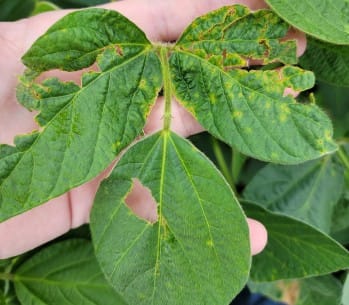Bacterial Leaf Blight: Good News, Bad News

 What is bacterial leaf blight? What causes it? Should you be doing anything about it?
What is bacterial leaf blight? What causes it? Should you be doing anything about it?
These are all valid and common questions when it comes to crop diseases. Fortunately, when it comes to bacterial leaf blight in soybeans, the answers are relatively straightforward.
Bacterial leaf blight is exactly what it sounds like—a bacterial infection that affects the leaves of soybeans. It is fairly common in our region and can resemble other diseases or herbicide injuries.
The bacteria survive on infected seeds and soybean residue, infecting plants early to mid-season, particularly during cool, wet weather. Sound familiar? You may have encountered bacterial leaf blight in 2024, but it likely didn’t affect your final yield.
Like most bacterial diseases, the bacteria travel through water and infect the plant via existing injuries, such as those caused by wind, storms or machinery. The bacteria can also enter the plant through small openings on the leaves known as stomata.
The silver lining is that bacterial leaf blight rarely impacts yield, which is fortunate given how common it is and how little we can do to prevent it. Yield loss can occur under extreme conditions but is uncommon. It’s worth noting, however, that growing beans-on-beans encourages the development of this disease and increases the likelihood of infection.
So, should you take any action? If so, what?
The short answer is no. In our region, most growers don’t need to worry about managing bacterial leaf blight because the pressure isn’t severe enough to warrant concern. However, if you notice a significant outbreak, rotating away from soybeans and avoiding monocropping can help reduce the disease risk in the affected field.











